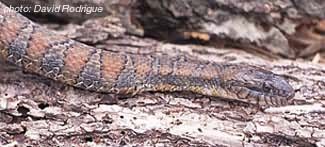

The Northern Water Snake is a medium sized snake, between 30 to 40 inches in length. They are generally tan or brown in color with broad black bands along the sides and the back. The belly of a water snake is generally lighter in color, ranging from white to yellowish with darker red crescent shaped markings. The water snake is not poisonous, but its bite can be painful.
As the name suggests, this type of snake lives mainly in and near the waters of lakes and ponds throughout the midwestern USA. It prefers slow moving streams and marshes but can survive even fast currents. This snake will also hide in river grasses or other plants growing near the water. It likes to lie on rocks or fallen logs to get sunlight during the day. The northern water snake eats mostly fish, frogs, toads, turtles, and salamanders. Unlike some other reptiles it is active during the day and the night, ready to hunt its prey. At times they will swim through the water with their mouths open ready to catch any fish or insect that happens to be passing by. Once caught, the water snake will swallow its prey alive.
Northern water snakes are active from April to October. They spend the winters hidden inside rockholes or in burrows near the water. Mating takes place in May or June, after the snakes have returned to their summer homes. Young snakes hatch in August or September; females can give birth to up to 60 young at a time.